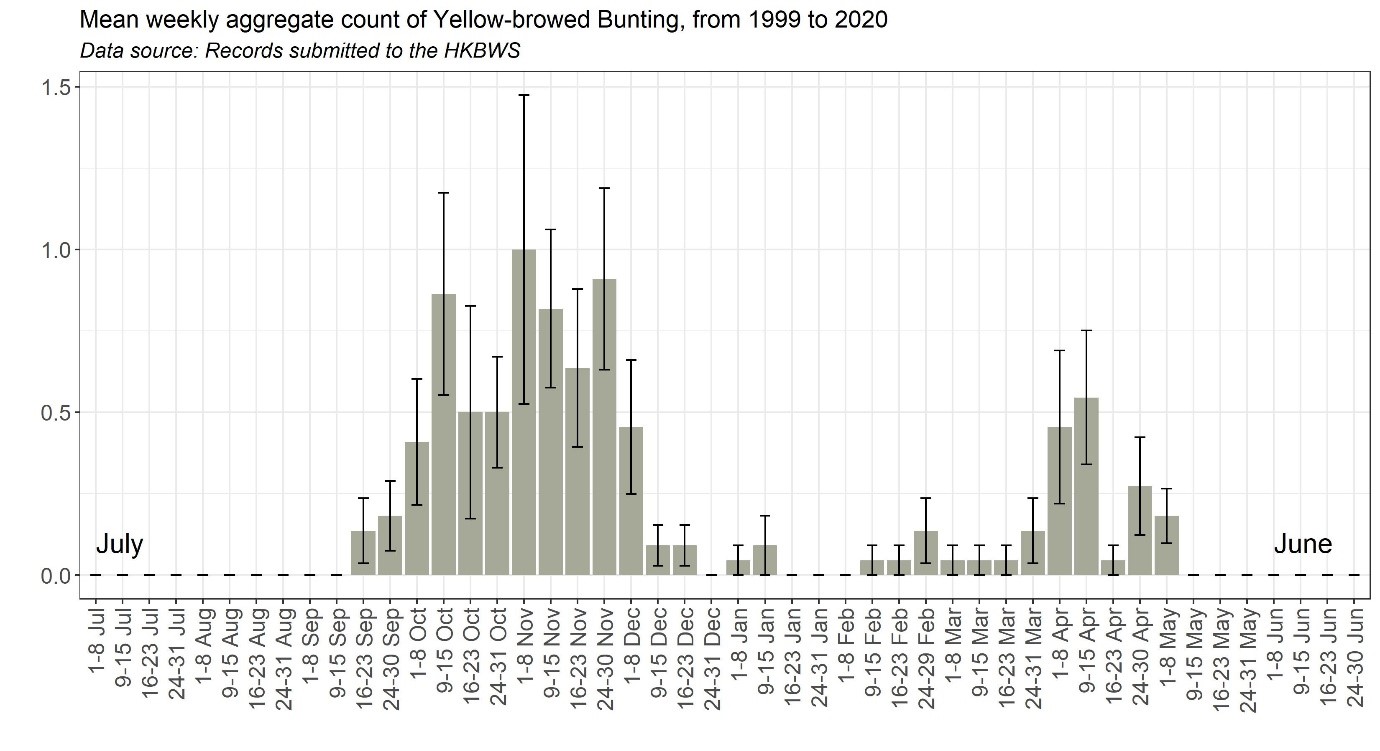Yellow-browed Bunting Emberiza chrysophrys 黃眉鵐
Category I. Scarce autumn migrant, less numerous in spring and rare in winter; occurs in a variety of open country habitats.
IDENTIFICATION

Apr. 2018, Koel Ko. Male moulting into breeding plumage.
13-15 cm. Male has contrasting head pattern of broad supercilium that begins just in front of eye and is yellow to just behind eye, broad white submoustachial, black crown sides, lores and ear coverts with white spot in rearmost corner. Underparts are whitish with distinct blackish streaks on chest, upper belly and buff tinged flanks, the mantle is warm brown up the centre, while the tertial edges, rump and uppertail coverts are chestnut. Adult males appear to be rare in HK.

Nov. 2013, Martin Hale. Female.
Females have a less contrasting head pattern due to dull sides to the crown, a subdued border to the ear coverts and paler yellow in the supercilium; the underparts are also less contrasting.
VOCALISATIONS
The typical call is a thin high-pitched ‘tzit’ very similar to a number of other buntings.
DISTRIBUTION & HABITAT PREFERENCE
About 70% of records since 1999 are divided equally between Po Toi and Long Valley. On the former it has occurred from 27 March to 7 May and from 22 September to 5 December, while at the latter site it has also been recorded in winter. As an open-country species it has also been recorded at sites such as Lam Tsuen, Kam Tin and fish pond and other wetland areas around Deep Bay. It is rare on the well-wooded islands of Lantau and HK Island.
Given the number of records at Long Valley, it is possible that the cultivation of rice, which has proved attractive to other buntings such as Yellow-breasted and Chestnut-eared, has also proved beneficial for Yellow-browed Bunting.
OCCURRENCE
First recorded in 1975, for much of the period since Yellow-browed Bunting was considered rare, with only 14 records involving 20 birds up to 1998. However, increased observer activity since 2007 particularly at two sites, Po Toi and Long Valley, indicates it occurs regularly, albeit scarcely.
Yellow-browed Bunting is a scarce passage migrant, mainly in autumn, with a handful of winter records (Figure 1). Main autumn passage occurs from the first week of October to the first week of December, peaking in November. Return passage possibly begins as early as the second week of February and peaks in the first half of April. Extreme dates are 21 September 2015 and 7 May 2011. The highest count is of five at Tan Shan valley on 15 November 1992. In addition, four were trapped at Kam Tin on 6 November 2009, while a further two were seen two days later. HK appears to lie just outside the main wintering range, as it occurs less than annually at this time of year.
Most records are of one or two birds. Occasional ex-captive individuals are recorded.
BEHAVIOUR, FORAGING & DIET
Has been observed feeding on seeds, but no details.
RANGE & SYSTEMATICS
Monotypic. Breeds in southeast Siberia north and northeast of Lake Baikal; winters in southeast China (Byers et al. 1995), where it occurs largely in coastal provinces south of the Chang Jiang (Yangtze River) but is a scarce winter visitor as far north as Beijing and west to Sichuan (Liu and Chen 2021, Birds of Beijing 2022).
CONSERVATION STATUS
IUCN: Least Concern. Population trend stable.
Figure 1.

Birding Beijing (2022). https://birdingbeijing.com/the-status-of-the-birds-of-beijing/ (Accessed 29 June 2022).
Byers, C., U. Olsson and J. Curson (1995). Buntings and Sparrows. A Guide to the Buntings and North American Sparrows. Pica Press, UK.
Liu, Y. and S. H. Chen (eds) (2021). The CNG Field Guide to the Birds of China (in Chinese). Hunan Science and Technology Publication House, Changsha.

